Sree Padmanabhaswamy Temple: 8th CE Spiritual Wonder & Mystery
Sree Padmanabhaswamy Temple is a Hindu temple dedicated to Lord Vishnu, located in Thiruvananthapuram, the capital of Kerala, India. It is one of the 108 Divya Desams, the holy abodes of Vishnu on Earth, and is considered one of the richest temples in the world.
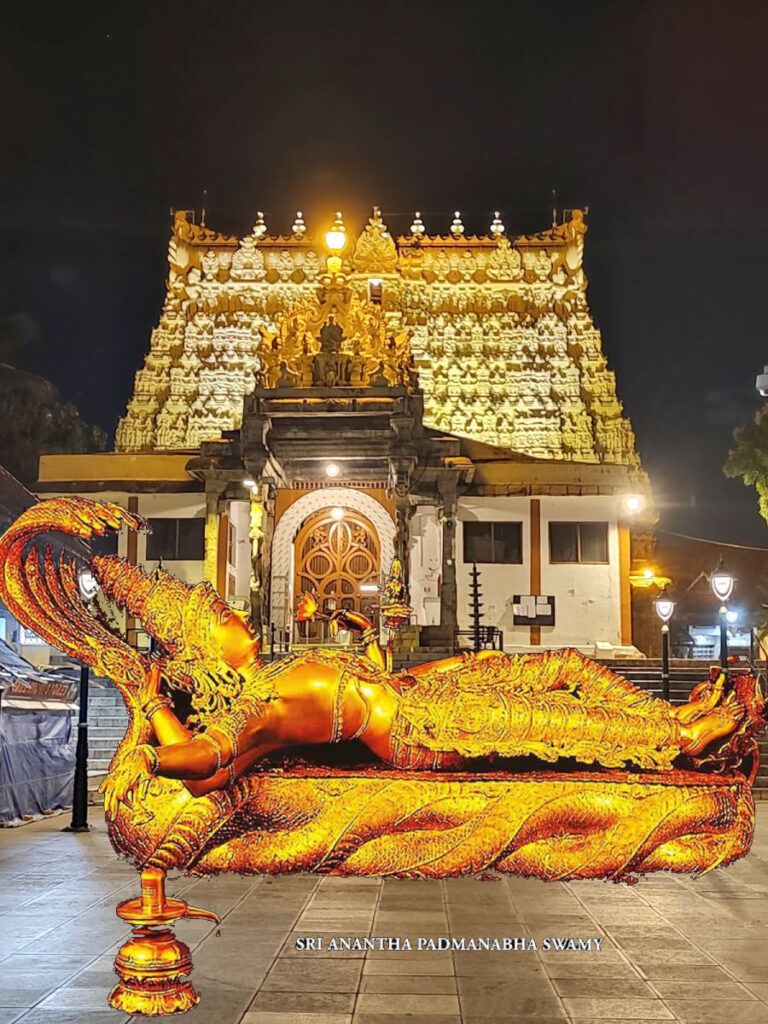
Contents
- 1 History of Sree Padmanabhaswamy Temple:
- 2 Significance of Sree Padmanabhaswamy Temple:
- 3 Legend of Sree Padmanabhaswamy Temple:
- 4 Myths of Sree Padmanabhaswamy Temple:
- 5 Mystery of Sree Padmanabhaswamy Temple:
- 6 Facts of Sree Padmanabhaswamy Temple:
- 7 Architecture of Sree Padmanabhaswamy Temple:
- 8 Miracles of Padmanabhaswamy Temple:
- 9 Sree Padmanabhaswamy Temple Timing:
- 10 Places to visit near Padmanabhaswamy Temple:
- 11 FAQ:
- 11.0.1 Q: Where is the Padmanabhaswamy Temple located?
- 11.0.2 Q: What is the dress code for the Padmanabhaswamy Temple?
- 11.0.3 Q: Is photography allowed inside the Padmanabhaswamy Temple?
- 11.0.4 Q: Can non-Hindus visit the Padmanabhaswamy Temple?
- 11.0.5 Q: What are the visiting hours of the Padmanabhaswamy Temple?
- 11.0.6 Q: What are the best times to visit the Padmanabhaswamy Temple?
- 11.0.7 Q: What are the main attractions of the Padmanabhaswamy Temple?
- 11.0.8 Q: Are there any special festivals celebrated at the Padmanabhaswamy Temple?
- 11.0.9 Q: Are there any other important things to know before visiting the Padmanabhaswamy Temple?
- 12 How to reach Padmanabhaswamy Temple:
- 13 Google Maps:
History of Sree Padmanabhaswamy Temple:
The history of the temple can be traced back to the 8th century CE, when the Alvar poet Nammalvar mentioned it in his hymns. It is believed that the temple was built by the Chera dynasty. The temple has been renovated and expanded over the centuries by various rulers, including the Travancore kings.
In 1686, a major fire destroyed most of the temple, except for the sanctum sanctorum. The temple was rebuilt by the Travancore king Marthanda Varma. The temple’s current structure dates back to the 18th century.
The Sree Padmanabhaswamy Temple is a unique example of Kerala style architecture. The temple complex consists of a series of concentric walls and courtyards. The sanctum sanctorum is located in the innermost courtyard. The temple has a seven-storey gopuram (gateway tower) at its eastern entrance.
The temple is dedicated to Vishnu, who is worshipped in the form of Ananta Padmanabha, the reclining Vishnu on the serpent Ananta. The temple’s main deity is a 18-foot long monolithic statue of Vishnu. The statue is made of a special alloy called Katusarkarayogam, which is said to be resistant to corrosion.
The Sree Padmanabhaswamy Temple is one of the richest Hindu temples in the world. In 2011, a Supreme Court-appointed committee opened five of the temple’s six secret vaults and discovered a treasure trove of gold, silver, and precious stones. The estimated value of the treasure was over $22 billion.
The Sree Padmanabhaswamy Temple is a major pilgrimage site for Hindus from all over the world. The temple is also a popular tourist destination.
Here is a brief timeline of the history of the Sree Padmanabhaswamy Temple:
- 8th century CE: The temple is mentioned in the hymns of the Alvar poet Nammalvar.
- 16th century: The Travancore kings renovate and expand the temple.
- 1686: A major fire destroys most of the temple, except for the sanctum sanctorum.
- 18th century: The temple is rebuilt by the Travancore king Marthanda Varma.
- 2011: A Supreme Court-appointed committee opens five of the temple’s six secret vaults and discovers a treasure trove of gold, silver, and precious stones.
Explore More Temples>> Jwalamukhi Temple Shaktinagar

Significance of Sree Padmanabhaswamy Temple:
Here are some of the reasons for the significance of Sree Padmanabhaswamy Temple:
- Religious significance: The temple is dedicated to Vishnu, one of the three main deities in Hinduism. Vishnu is the preserver god, and is believed to be the source of all life. The temple is a major pilgrimage site for Hindus, and millions of people visit it every year to worship Vishnu.
- Cultural significance: The temple is a symbol of the rich cultural heritage of Kerala. The temple architecture is a fusion of Kerala and Dravidian styles, and the temple complex is home to a number of murals and sculptures that depict Hindu mythology. The temple also hosts a number of festivals throughout the year, which attract devotees from all over India.
- Historical significance: The temple has a long and rich history, dating back to at least the 8th century AD. The temple has been ruled by a number of dynasties over the centuries, and has been a major center of Hindu culture and learning.
- Wealth: The temple is known for its immense wealth, which includes a vast collection of gold, silver, and precious stones. The temple treasure is estimated to be worth billions of dollars, making it one of the richest religious institutions in the world.
Explore More Temples>> Char Dham Yatra – A Complete Guide to Spiritual Destination
Legend of Sree Padmanabhaswamy Temple:
There are many legends associated with the Sree Padmanabhaswamy Temple. One of the most popular legends is that the temple was consecrated by a Tulu Brahmin hermit named Divakara Muni. According to legend, Divakara Muni was a great devotee of Vishnu and performed in-depth meditation in order to attract the divine. One day, Lord Vishnu appeared in front of him as a small boy child. The hermit requested the God-like child to stay with him in the Hermitage. The child agreed, but there was a condition. If the hermit failed to treat him with respect, the child would vanish.
One day, the hermit was so engrossed in his meditation that he forgot to feed the child. The child became angry and disappeared. The hermit was devastated and searched for the child all over the forest, but could not find him. Finally, he returned to his Hermitage and prayed to Lord Vishnu for forgiveness. Lord Vishnu appeared before him and said that he would return to the Hermitage the next day.
The next day, the hermit was ready to greet the child with respect. However, the child did not return. The hermit was heartbroken and prayed to Lord Vishnu again. Lord Vishnu appeared before him and said that he would stay in the Hermitage forever, but only in the form of an idol. The hermit agreed and Lord Vishnu took the form of a reclining idol made of black stone.
Explore More Temples>> Brihadeeswarar Temple: Timeless Marvel of Chola Architecture
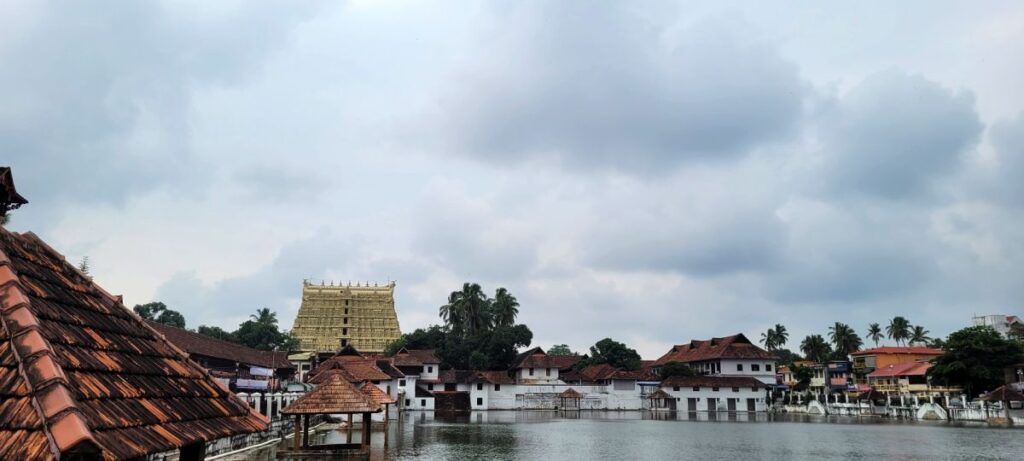
Myths of Sree Padmanabhaswamy Temple:
The Sree Padmanabhaswamy Temple in Thiruvananthapuram, India is one of the richest temples in the world, and is also shrouded in mystery. There are many myths and legends associated with the temple, some of which are listed below:
- Vault B: One of the most famous myths is that Vault B of the temple houses a treasure trove of unimaginable value, including gold coins, jewels, and ancient artifacts. The vault has been sealed for centuries, and there is much speculation about what lies inside. Some believe that the treasure is so vast that it could destabilize the global economy if it were ever released. Others believe that the vault is guarded by powerful curses, and that anyone who tries to open it will face dire consequences.
- The Curse of the Nagas: It is said that the temple is built on a snake pit, and that the Nagas (serpent deities) who reside there guard the temple’s treasures. According to legend, anyone who tries to steal the treasure will be cursed by the Nagas and will suffer a terrible fate.
- The Secret Passage: There is a rumor that there is a secret passage that leads from the temple to the nearby Ananthapura Lake. It is said that the Travancore royal family used this passage to escape with the temple’s treasures during times of war or unrest. Some people believe that the secret passage still exists, and that it is guarded by the royal family.
- The Temple’s Energy: Many people believe that the Sree Padmanabhaswamy Temple is a powerful energy center. Some people say that they have experienced strange phenomena while visiting the temple, such as visions, dreams, and feelings of euphoria. Others believe that the temple has healing powers, and that people who visit the temple are often cured of their ailments.
Explore More Temples>> Arupadai veedu Murugan Temples | Six Abodes of Lord Murugan
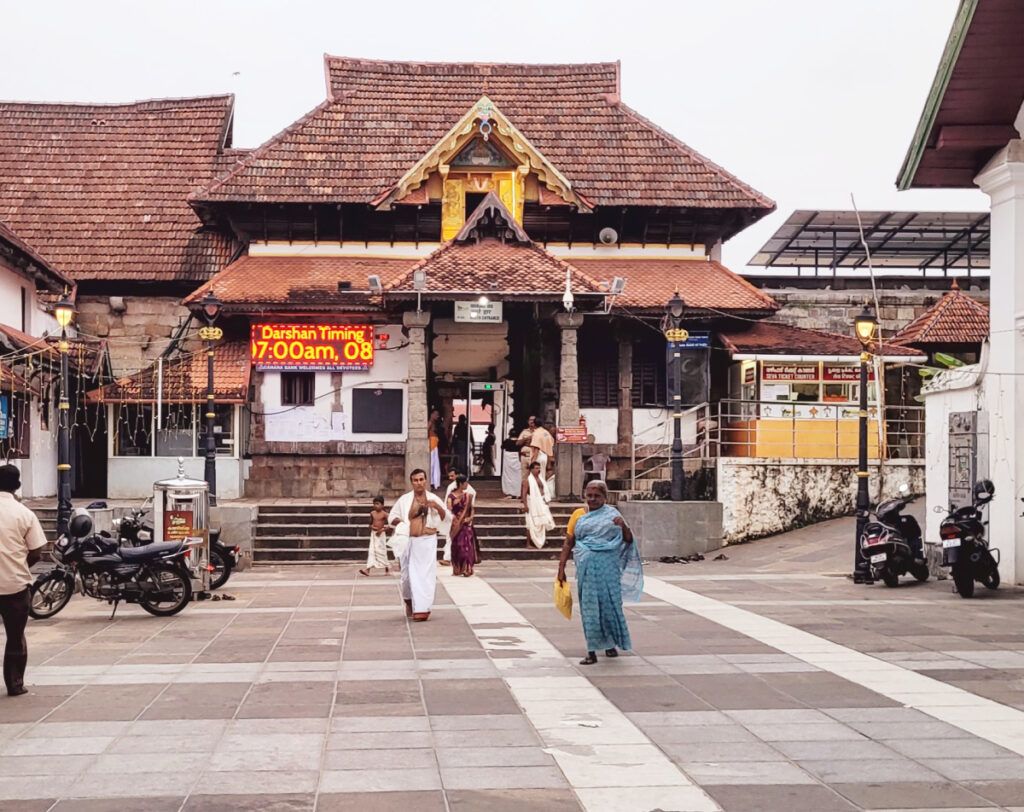
Mystery of Sree Padmanabhaswamy Temple:
The temple is also known for its immense wealth, which was discovered in 2011. Six hidden vaults were found beneath the temple, containing a vast treasure trove of gold, jewels, and other precious artifacts. The estimated value of the treasure is estimated to be over $20 billion, making it the richest temple in the world.
One of the most intriguing mysteries surrounding the Padmanabhaswamy Temple is the contents of Vault B. This vault is the largest and most secure of the six vaults, and it remains unopened to this day. There is much speculation about what might be hidden inside, with some people believing that it contains the most valuable and sacred treasures of the temple.
Another mystery surrounding the temple is the curse that is said to be associated with it. Legend has it that anyone who attempts to open Vault B will be cursed by the gods and will face dire consequences. This belief is reinforced by the fact that several people who have been involved in the opening of the other vaults have died or suffered misfortunes shortly thereafter.
The mystery of the Padmanabhaswamy Temple has attracted the attention of people from all over the world. Some believe that the vault contains ancient secrets and knowledge that could have a profound impact on our understanding of the world. Others believe that it is simply a place where the Travancore royal family stored their wealth.
Regardless of what is hidden inside Vault B, the mystery of the Padmanabhaswamy Temple remains one of the most fascinating and intriguing in the world. It is a reminder of the rich history and culture of India, and of the power of faith and tradition.
Explore More Temples>> Konark Sun Temple 13th Century Gem
Facts of Sree Padmanabhaswamy Temple:
Here are some facts about the Sree Padmanabhaswamy Temple in Thiruvananthapuram, Kerala, India:
- It is one of the 108 Divya Desams dedicated to Lord Vishnu, and is widely considered as the world’s richest Hindu temple.
- The name of the city of “Thiruvananthapuram” in Malayalam and Tamil translates to “The City of Ananta” (Ananta being a form of Vishnu).
- The temple is built in an intricate fusion of the Kerala style and the Dravidian style of architecture, featuring a 16th-century gopura.
- The presiding deity is made of fossilized shells and is depicted reclining on the serpent Anantha or Adi Sesha.
- In 2011, a treasure trove of gold and precious stones worth an estimated ₹1 trillion (US$120 billion) was discovered in six secret chambers beneath the temple.
- The temple is one of the most popular pilgrimage sites in India and is visited by millions of devotees every year.
Here are some other interesting facts about the temple:
- The temple is believed to be over 5,000 years old, but the current structure is thought to have been built around the 16th century.
- The temple is a major center for the study of Hindu philosophy and scriptures.
- The temple is also known for its unique temple rituals and festivals.
- The temple is governed by a royal trust, which includes the Travancore royal family.
Explore More Temples>> Enchanting Beauty of Madurai Meenakshi Amman Temple
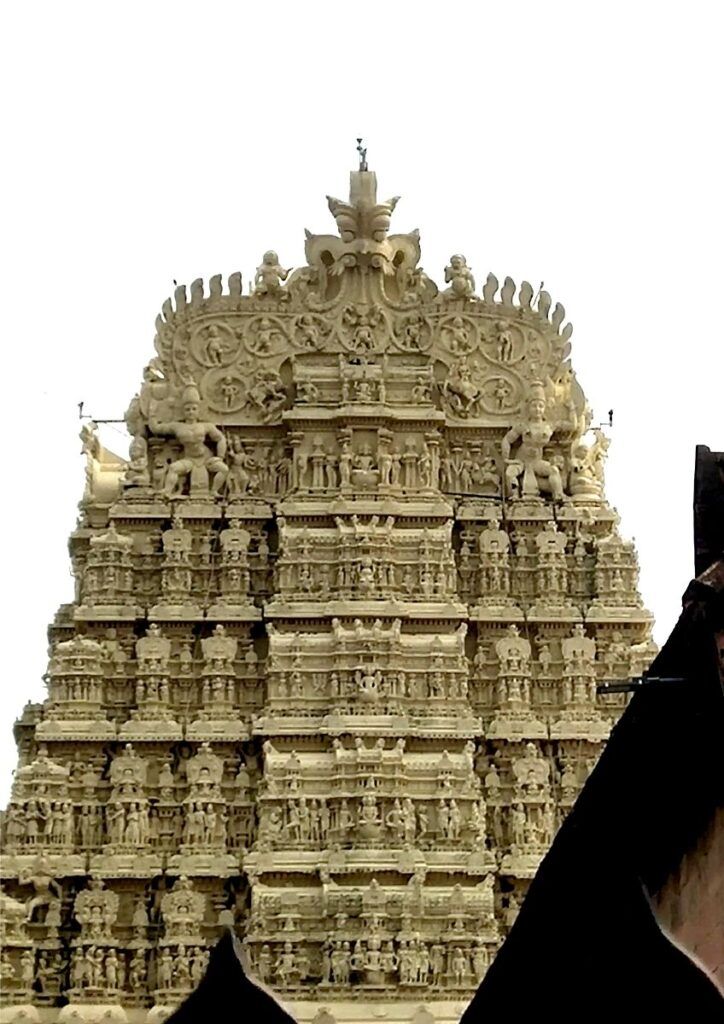
Architecture of Sree Padmanabhaswamy Temple:
Dravidian Style: The temple follows the traditional Dravidian architectural style, which is characteristic of South Indian temples. This style is known for its pyramid-shaped towers, intricately carved sculptures, and precise geometric proportions.
Gopurams: The temple complex features several gopurams (ornate gateways or towers), with the principal gopuram being the most prominent. This towering structure is adorned with intricate sculptures and figurines, depicting various gods and goddesses.
Outer Walls: The outer walls of the temple are embellished with intricate carvings of various deities and mythological stories from Hindu scriptures. These carvings are a testament to the skill and artistry of the craftsmen who built the temple.
Granite Structure: The temple is primarily constructed using granite stone, a durable material that has withstood the test of time, ensuring the longevity of the temple’s architectural beauty.
Seven-Storey Gopuram: The main entrance gopuram of the temple has seven stories, making it one of the tallest temple towers in South India. The height of this gopuram is a remarkable architectural achievement.
Inner Sanctum: The inner sanctum of the temple houses the principal deity, Lord Padmanabhaswamy, in a reclining position on the serpent Ananta Shesha. The sanctum is covered in gold, and only Hindus are allowed to enter it for worship.
Circular Mandapa: The temple has a circular mandapa (hall) known as the Sreebali. It is adorned with 365 intricately carved pillars, representing the days of the year. The mandapa serves as a venue for various religious ceremonies.
Kuthira Malika: Located near the temple, Kuthira Malika is a palace built by the Maharaja of Travancore, Swathi Thirunal Rama Varma, in the 1840s. The palace is known for its architectural beauty and is famous for its 122 wooden horses that are part of its ornate frieze.
Ottakkal Mandapam: This is a pavilion with a granite foundation that is used for the annual Aaraattu festival. The festival involves the procession of the deities to the Shanghumugham Beach.
Ganesha Shrine: The temple complex also includes a separate shrine dedicated to Lord Ganesha, the elephant-headed god of wisdom and beginnings.
Explore More Temples>> Vijayawada Kanaka Durga Temple: A Beacon of Hope & Strength
Miracles of Padmanabhaswamy Temple:
Here are some of the miracles associated with the Padmanabhaswamy Temple:
- The Self-illuminating Deity: The idol of Lord Padmanabha is said to be self-illuminating. Even when the temple is plunged into darkness, the idol can be seen clearly.
- The Miraculous Doors: The temple has six secret vaults, which are said to be guarded by snakes and Nagas (serpent deities). The doors to these vaults are said to open only to a person who knows the secret mantra.
- The Milk Miracle: Every year, during the monsoon season, milk is said to flow from the walls of the temple. This miracle is said to be a blessing from Lord Padmanabha.
- The Unexplained Fires: The temple has been ravaged by fires on several occasions, but the idol of Lord Padmanabha has always been miraculously saved.
- The Mysterious Treasure: The temple’s treasure is said to be protected by a powerful curse. It is believed that if the treasure is ever removed from the temple, it will bring disaster upon the world.
There are many other miracles associated with the Padmanabhaswamy Temple, but these are just a few of the most well-known ones. The temple continues to be a place of mystery and wonder, and it attracts pilgrims from all over the world.
In addition to the miracles mentioned above, there are many other stories and legends associated with the Padmanabhaswamy Temple. For example, it is said that the temple was built over 5,000 years ago by the Vishwakarma, the divine architect. It is also said that the temple is located on a sacred spot where Lord Vishnu is said to have manifested himself as Anantha Padmanabha.
Explore More Temples>> Arunachaleswara Temple: A Spiritual Experience of a Lifetime
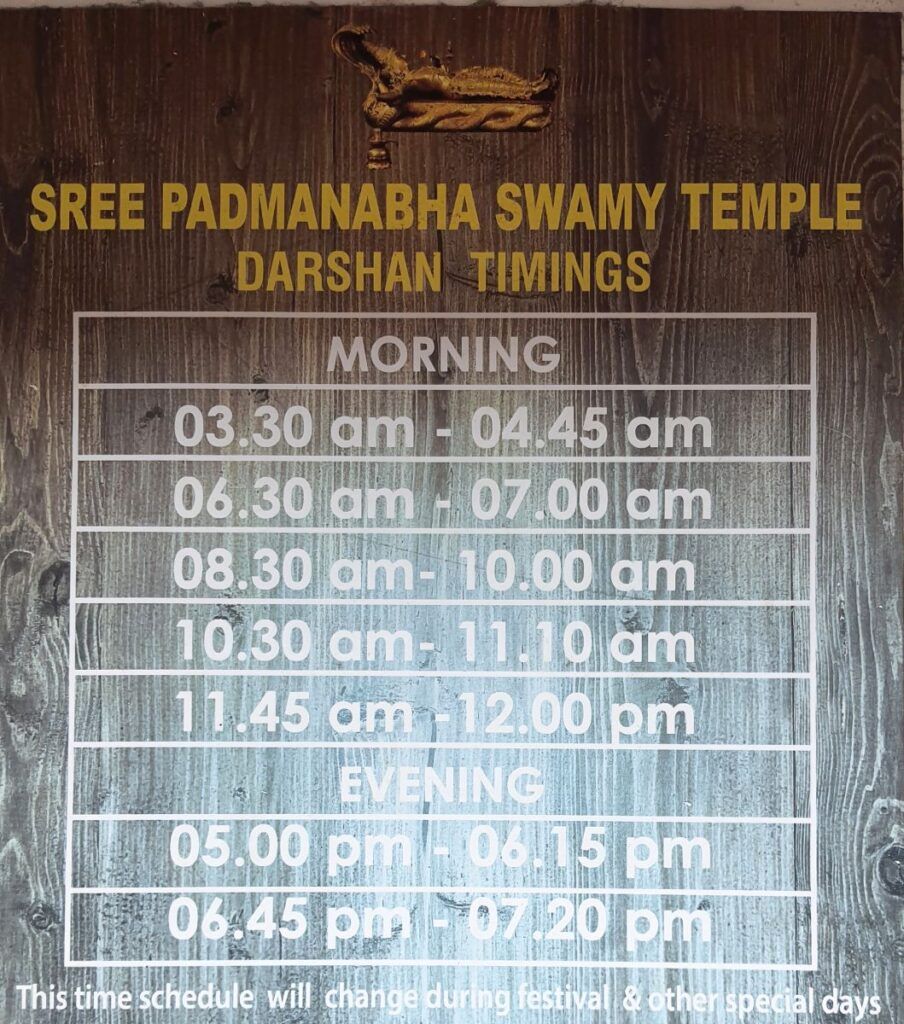
Sree Padmanabhaswamy Temple Timing:
Morning Timing:
- Darshan (Worship): 3:30 AM to 4:45 AM
- Nirmalya Darshan: 6:30 AM to 7:00 AM
- Usha Puja: 7:15 AM to 8:15 AM
- Morning Seeveli: 8:45 AM to 9:15 AM
- Temple Closes: 10:00 AM
Evening Timing:
- Temple Reopens: 5:00 PM
- Deeparadhana (Evening Pooja): 6:15 PM to 6:45 PM
- Evening Seeveli: 6:45 PM to 7:15 PM
- Athazha Puja: 7:30 PM to 8:30 PM
- Temple Closes: 8:45 PM
Places to visit near Padmanabhaswamy Temple:
Kuthira Malika (Puthen Malika Palace): This historic palace, located near the temple, is known for its beautiful architecture and collections of artifacts, including the personal belongings of the Travancore kings.
Napier Museum and Art Gallery: A short distance from the temple, this museum showcases a diverse collection of art and historical artifacts, including sculptures, bronze idols, and other exhibits.
Kovalam Beach: Approximately 16 kilometers from the temple, Kovalam Beach is a popular destination for its golden sands, clear waters, and beachside activities.
Vizhinjam Marine Aquarium: Located near Kovalam Beach, this aquarium features a variety of marine life and is an excellent place for those interested in underwater ecosystems.
Attukal Bhagavathy Temple: About 2 kilometers from Sree Padmanabhaswamy Temple, this temple is dedicated to the goddess Attukal Bhagavathy and is famous for the annual Attukal Pongala festival.
Shanghumukham Beach: This serene beach is around 7 kilometers from the temple and is known for its calm waters and a sculpture of a mermaid called “Matsya Kanyaka.”
Sri Chitra Art Gallery: Located within the Napier Museum, this art gallery showcases an impressive collection of Indian paintings, including works by Raja Ravi Varma and other famous artists.
The Kanakakunnu Palace: This palace, also known as Kanakakunnu Palace, is situated near the Napier Museum. It hosts cultural events and exhibitions and is surrounded by beautiful gardens.
Aruvikkara Dam: Located about 16 kilometers from the temple, this dam is a popular picnic spot and offers scenic views of the river and surrounding landscape.
Veli Tourist Village: Situated around 8 kilometers from the temple, this village features a beautiful garden, a floating bridge, and water sports facilities, making it an ideal spot for family outings.
Neyyar Wildlife Sanctuary: Located about 30 kilometers from Thiruvananthapuram, this sanctuary is home to a variety of wildlife and offers opportunities for hiking, wildlife viewing, and boating.
Agasthyarkoodam: If you’re interested in trekking and nature, you can plan a visit to Agasthyarkoodam, a peak in the Western Ghats. It’s approximately 50 kilometers from the temple and requires special permissions for trekking.
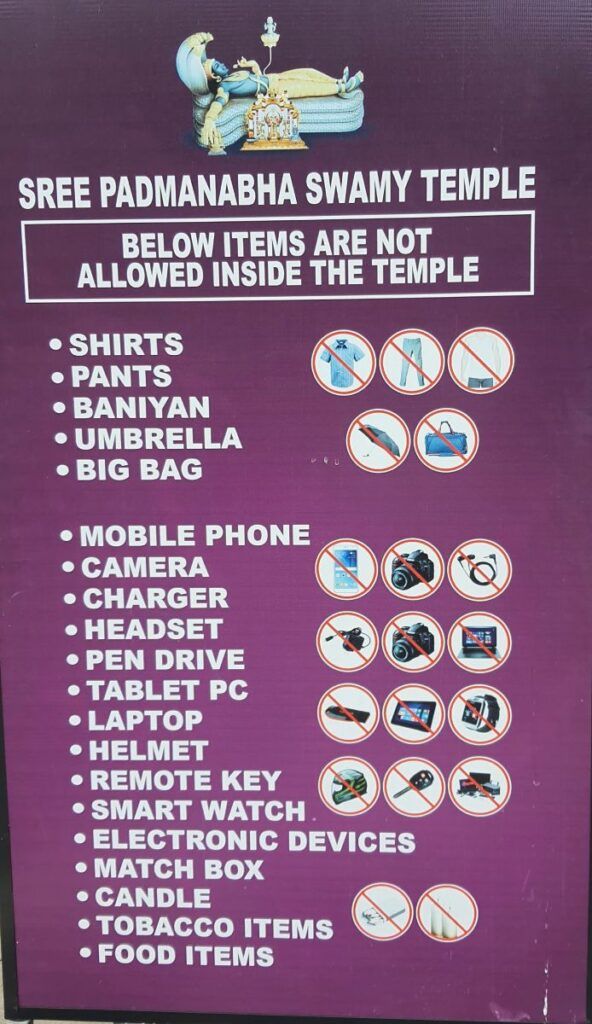
FAQ:
Q: Where is the Padmanabhaswamy Temple located?
A: The Padmanabhaswamy Temple is located in the city of Thiruvananthapuram, Kerala, India. It is one of the most famous and wealthy temples in the world.
Q: What is the dress code for the Padmanabhaswamy Temple?
A: The Padmanabhaswamy Temple has a strict dress code for both men and women. Men must wear a dhoti with or without an angavastram (upper cloth). Women must wear a saree or a half-saree only. Dhotis and sarees are available for hire outside the temple premises.
Q: Is photography allowed inside the Padmanabhaswamy Temple?
A: No, photography is not allowed inside the Padmanabhaswamy Temple.
Q: Can non-Hindus visit the Padmanabhaswamy Temple?
A: No, the Padmanabhaswamy Temple is open to Hindus only.
Q: What are the visiting hours of the Padmanabhaswamy Temple?
A: The Padmanabhaswamy Temple is open from 3:30 AM to 12:30 PM and from 5:00 PM to 8:30 PM on all days of the week.
Q: What are the best times to visit the Padmanabhaswamy Temple?
A: The best times to visit the Padmanabhaswamy Temple are during the morning and evening poojas (prayer rituals). The morning pooja is performed from 6:30 AM to 7:30 AM, and the evening pooja is performed from 6:00 PM to 7:00 PM.
Q: What are the main attractions of the Padmanabhaswamy Temple?
A: The main attractions of the Padmanabhaswamy Temple are the deity of Lord Vishnu reclining on the serpent Ananta Shesha, the nine-story Gopuram (gateway tower), and the temple complex, which is a mix of Kerala and Dravidian architecture.
Q: Are there any special festivals celebrated at the Padmanabhaswamy Temple?
A: Yes, there are many special festivals celebrated at the Padmanabhaswamy Temple, including the Navaratri festival, the Vishnu Jayanti festival, and the Padmanabhaswamy Jayanti festival.
Q: Are there any other important things to know before visiting the Padmanabhaswamy Temple?
A: Yes, there are a few other important things to know before visiting the Padmanabhaswamy Temple:
- Visitors must remove their footwear before entering the temple complex.
- Visitors are not allowed to carry any electronic devices, such as mobile phones and cameras, inside the temple complex.
- Visitors are not allowed to bring any food or drinks inside the temple complex.
- Visitors are requested to be respectful of the temple’s dress code and customs.
How to reach Padmanabhaswamy Temple:
By Air:
The nearest airport to Thiruvananthapuram is the Trivandrum International Airport (Thiruvananthapuram Airport). You can book a flight to this airport from major cities in India and some international destinations. From the airport, you can hire a taxi or take a bus to reach the temple, which is about 5 kilometers away.
By Train:
Thiruvananthapuram has a major railway station, Thiruvananthapuram Central, which is well-connected to other parts of India. Once you arrive at the railway station, you can hire a taxi or take a local bus to reach the temple. The temple is approximately 1.5 kilometers from the railway station.
By Road:
Thiruvananthapuram is well-connected by road, and you can reach the city by bus or car. If you’re traveling by bus, you can take a state-run or private bus to Thiruvananthapuram’s Central Bus Station. From there, you can hire a taxi or take a local bus to the temple.
Local Transport:
Once you’re in Thiruvananthapuram, you can use local transportation options like auto-rickshaws or taxis to reach the Sree Padmanabhaswamy Temple. It’s a prominent landmark, and most local drivers will be familiar with its location.

One Comment